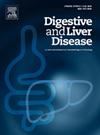组织学评分无法预测急性重度溃疡性结肠炎的短期疗效:一项观察性研究。
IF 4
3区 医学
Q1 GASTROENTEROLOGY & HEPATOLOGY
引用次数: 0
摘要
背景:各种组织学评分在预测急性重症溃疡性结肠炎(ASUC)预后中的作用尚未得到研究:各种组织学评分在预测急性重度溃疡性结肠炎(ASUC)预后方面的作用尚未得到研究:方法:纳入连续接受乙状结肠镜检查和由两名独立病理学家进行组织学评估的急性重症溃疡性结肠炎患者,评估指标包括简化吉布斯评分(SGS)、罗巴特组织病理学指数(RHI)和南希组织病理学指数(NHI)]。主要结果是组织学在预测是否需要二线治疗或结肠切除术方面的作用:在82例ASUC患者中(平均年龄:36岁,男性占47.5%),有27例(32.9%)对类固醇治疗无反应。16名患者需要接受二线药物治疗,8名患者需要进行结肠切除术。二线治疗或结肠切除术的需求与基线组织学评分[NHI (p = 0.61)、SGS (p = 0.116) 和 RHI (p = 0.109)]之间没有明显关联。这三个评分在预测是否需要二线治疗或在 28 天内进行结肠切除术方面均表现不佳。组织学评分与类固醇反应(NHI (p = 0.796)、SGS (p = 0.57) 和 RHI (p = 0.941))之间无明显关联。所有三个评分之间都有很强的正相关性,但与内镜下的梅奥评分没有相关性:结论:三种组织学评分(SGS、RHI 和 NHI)在预测 ASUC 是否需要二线治疗或结肠切除术方面表现不佳。今后的研究应探讨组织学评估对 ASUC 长期预后的影响。本文章由计算机程序翻译,如有差异,请以英文原文为准。
Histological scores are poor predictors of short term outcomes in acute severe ulcerative colitis: An observational study
Background
The role of various histologic scores in predicting outcomes in acute severe ulcerative colitis (ASUC) is unexplored.
Methods
Consecutive patients of ASUC undergoing sigmoidoscopy and histological assessment by two independent pathologists for Simplified Geboes score (SGS), Robarts Histopathology Index (RHI) and Nancy histological index (NHI)] were included. Primary outcome was the role of histology in predicting need for second-line therapy or colectomy.
Results
Of 82 patients with ASUC (mean age: 36 years, males 47.5 %), non-response to steroids was observed in 27 (32.9 %) of cases. Sixteen patients required second-line drug therapy and 8 required colectomy. There was no significant association between the need for second-line therapy or colectomy and the baseline histological scores [NHI (p = 0.61), SGS (p = 0.116) and RHI (p = 0.109)]. All three scores performed poorly to predict the need for second-line treatment or colectomy within 28 days. There was no significant association between histological scores and steroid response (NHI (p = 0.796), SGS (p = 0.57) and RHI (p = 0.941)]. All three scores had a strong positive correlation observed between each other but not with endoscopic Mayo score.
Conclusion
The three histologic scores (SGS, RHI and NHI) performed poorly in prediction of need for second-line treatment or colectomy in ASUC. Future studies should study the impact of histologic assessment on long term outcomes in ASUC.
求助全文
通过发布文献求助,成功后即可免费获取论文全文。
去求助
来源期刊

Digestive and Liver Disease
医学-胃肠肝病学
CiteScore
6.10
自引率
2.20%
发文量
632
审稿时长
19 days
期刊介绍:
Digestive and Liver Disease is an international journal of Gastroenterology and Hepatology. It is the official journal of Italian Association for the Study of the Liver (AISF); Italian Association for the Study of the Pancreas (AISP); Italian Association for Digestive Endoscopy (SIED); Italian Association for Hospital Gastroenterologists and Digestive Endoscopists (AIGO); Italian Society of Gastroenterology (SIGE); Italian Society of Pediatric Gastroenterology and Hepatology (SIGENP) and Italian Group for the Study of Inflammatory Bowel Disease (IG-IBD).
Digestive and Liver Disease publishes papers on basic and clinical research in the field of gastroenterology and hepatology.
Contributions consist of:
Original Papers
Correspondence to the Editor
Editorials, Reviews and Special Articles
Progress Reports
Image of the Month
Congress Proceedings
Symposia and Mini-symposia.
 求助内容:
求助内容: 应助结果提醒方式:
应助结果提醒方式:


